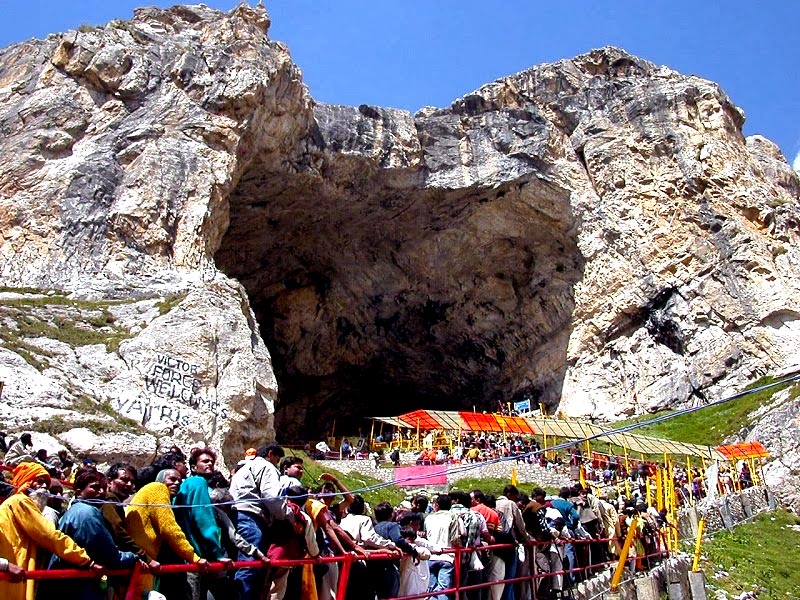AMARNATH YATRA

Amarnath cave is a Hindu shrine located in Jammu and Kashmir, India. The cave is situated at an altitude of 3,888 m (12,756 ft), about 141 km (88 mi) from Srinagar, the capital of Jammu and Kashmir and reached through Pahalgam town. The shrine forms an important part of Hinduism, and is considered to be one of the holiest shrines in Hinduism. The cave is surrounded by snowy mountains. The cave itself is covered with snow most of the year except for a short period of time in summer when it is open for pilgrims. Thousands of Hindu devotees make an annual pilgrimage to the Amarnath cave on challenging mountainous terrain to see an ice stalagmite formed inside the cave.
Inside the 40 m (130 ft) high Amarnath cave, the stalagmite is formed due to freezing of water drops that fall from the roof of the cave on to the floor and grows up vertically from the cave floor. It is considered to be a Shiva Linga by Hindus. The Cave waxes during May to August, as snow melts in the Himalayas above the cave and the resultant water seeps into the rocks that form the cave and gradually wanes thereafter. As per the religious beliefs, it has been claimed that the lingam grows and shrinks with the phases of the moon reaching its height during the summer festival, although there is no scientific evidence for this belief.
According to a Hindu legend, this is the cave where Shiva explained the secret of life and eternity to his divine consort, Parvati. Two other ice formations represent Parvati and Shiva’s son, Ganesha.
The main purpose of the annual pilgrimage to the cave is worship of the ice stalagmite Lingam.
There are references to the legendary king Aryaraja (ascribed dates 300 BCE) who used to worship a lingam formed of ice in Kashmir. The book Rajatarangini (Book VII v.183) refers to Amareshwara or Amarnath. It is believed that Queen Suryamathi in the 11th century AD gifted trishuls, banalingas and other sacred emblems to this temple. Rajavalipataka, begun by Prjayabhatta has detailed references to the pilgrimage to Amarnath Cave. Other than this, there are further references to this pilgrimage in many other ancient texts.
The temple is a popular yatra destination for Hindus. In 2011 it received about 634,000 persons, the highest recorded number for the site. The number was 622,000 in 2012 and 350,000 in 2013. Pilgrims visit the holy site during the 45-day season around the festival of Shravani Mela in July–August, coinciding with the Hindu holy month of Shraavana.
The beginning of the annual pilgrimage, called Amarnath Yatra is marked by ‘pratham pujan’ to invoke the blessings of Shri Amarnathji.

KAILASH MANSAROVAR YATRA

An imposing 21,778-feet tall, the magnificent and majestic Mount Kailash is more than just a mountain. It’s a legend. A revelation. An epiphany. A journey, that is both outwards and inwards. Located in the Himalayan mountain ranges of the remote Southwestern corner of Tibet, Kailash is not just one of the highest parts of the world and the source of four mighty rivers of Asia — the Brahmaputra, the Sutlej, Ganges and the Indus — but it’s also one of the most significant spiritual spots in the world, revered by millions of people from different religions across the world.
But more than anything, the journey to Kailash Mansarovar is a life-changing experience for the few thousands of pilgrims who undertake it every year, teaching them a sense of self like nothing else can. For a pilgrimage to this isolated, timeless, breathtaking and fascinating spiritual spot is like a journey within yourself.
The Kailash Parvat or Mount Kailash along with the holy Manasarovar lake is deeply integral to the heart of spiritual Asia, capturing the imagination of human beings since time immemorial. According to Hindu legend, the lake was first created in the mind of the Lord Brahma. Hence, in Sanskrit it is called Manasarovar, which is a combination of the words ‘Manas’ (mind) and ‘Sarovar’ (lake). Hindus also believe Mt. Kailash to be the abode of Lord Shiva, the holy centre of the earth and the manifestation of heaven itself.Tibetan Buddhists profess that Kailash is the home of the Buddha Demchok who symbolizes supreme harmony. The Tibetan religion of ‘Bon’ believes Mount Kailash as their spiritual seat of power.
In Jainism, Kailash, referred to as Mount Ashtapada, is the place where the creator of their faith, Rishabhadeva, attained freedom from the cycle of life and rebirth.
Just 20 kilometers away from Mount Kailash, the sacred blue and emerald green Manasarovar lake that lies at a height of 15,015 ft, is known to be an epitome of purity, containing healing properties and the power to wash off all mortal sins.
For these reasons and more, a trip to Kailash Manasarovar is an intense spiritual experience, complete with the inclusion of meditation sessions, sathsangs ( spiritual discourses) and much more.
A sojourn to this roof of the world is an arduous, but rewarding one. Every single traveler of this incredible journey undergoes a humbling and enlightening transformation, which cannot be described, but can only be felt first hand.

MANIMAHESH YATRA

The paradisiacal land of Himachal Pradesh is home to many historical and religious sites. The state boasts of several exciting pilgrimage trails leading to sacred temples. The Manimahesh Yatra is one such pilgrimage, which starts from Lakshminarayan Temple in Chamba and ends at the Manimahesh Lake in Bundhil valley. The Manimahesh Lake is believed to be one of the abode of Lord Shiva as per the Hindu mythologies.
The holy trek or Yatra is set about fifteen days after the festival of Janmashtami. The pilgrims walk along the rocky path completely bare footed, singing Bhajans and praying ecstatically to Lord Shiva. After reaching Manimahesh Lake, they take dips in the holy water. With the termination of the Manimahesh Yatra, the devotees visit the ancient temple of Chatrari, which is located between Bharmaur and Chamba.
Manimahesh Lake (also known as Dal Lake, Manimahesh), situated in the Pir Panjal Range of the Himalayas, is a high altitude lake (el. 4080 m.). The Manimahesh Kailash peak stands high close to the lake. The religious sanctity of this place is next to the Lake Manasarovar.
The route to Manimahesh is via Chamba, Himachal Pradesh, Bharmour and Hadsar. Motorable road goes till Hadsar. The rest of the path is to be covered on foot, about 13 km of steep climb by the banks of Manimahesh Ganga, which originates from the Manimahesh Kailash peak. During the annual pilgrimage in August – September, numerous night-shelters and eateries spring up by the trekking route. Night-shelter is also available at village Dhancho, about 6 km from Hadsar on the way to Manimahesh, round the year. Another less frequented trekking route originates from Holi, which is connected to Chamba.
Walking to the way of the Manimahesh Lake is a wonderful experience. One will forget the pains of the tiresome journey watching the wonderful natural scenery and get drenched in the enchanting ambience. This wonderful route not only excites the pilgrims but also, the adventure lovers and tourists. However, one should be physically fit to endure this journey in an altitude of 4080 meters.
The name Manimahesh signifies a jewel (Mani) on Lord Shiva’s crown. Local people claim that the moon-rays reflected from the jewel can be seen from Manimahesh Lake on clear full-moon nights (which is a rare occasion). It is more likely to be the light reflected from the glacier that adorns the peak, like a serpent on Shiva’s neck.
The Manimahesh Yatra in Himachal Pradesh is treated as a state level fair as per the declaration of the Himachal Pradesh State Government. The Himachal tourism department has undertaken various plans and programs to promote this wonderful event.
Sources: wikipedia.org, sacredwalks.org, newsonair.nic.in




